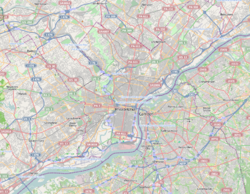Arch Street Friends Meeting House
|
Arch Street Meeting House
|
|

(2013)
|
|
| Location | 320 Arch Street Philadelphia, Pennsylvania |
|---|---|
| Coordinates | 39°57′7.2″N 75°8′50.17″W / 39.952000°N 75.1472694°WCoordinates: 39°57′7.2″N 75°8′50.17″W / 39.952000°N 75.1472694°W |
| Built | 1803–05, 1810–11 |
| Architect | Owen Biddle, Jr. (central structure and east wing) |
| NRHP Reference # | 71000716 |
| Significant dates | |
| Added to NRHP | May 27, 1971 |
| Designated NHL | June 23, 2011 |
| Designated PHMC | December 17, 1954 |
The Arch Street Friends Meeting House, at 320 Arch Street at the corner of 4th Street in the Old City neighborhood of Philadelphia, Pennsylvania, is a Meeting House of the Religious Society of Friends (Quakers). Built to reflect Friends’ testimonies of simplicity and equality, this building is little changed after more than two centuries of continuous use.
Pennsylvania founder and Quaker William Penn deeded land to the Society of Friends in 1701 to be used as a burial ground. The east wing and center of the meetinghouse was built between 1803 and 1805 according to a design by the Quaker carpenter Owen Biddle, Jr. Biddle is best known as the author of a builder’s handbook, The Young Carpenter's Assistant, published in 1805. The building was enlarged in 1810–11, with the addition of the west wing. Architects Walter Ferris Price and Morris & Erskine also contributed to the design and construction of the building. The firm Cope & Lippincott renovated the interior of the east wing and designed the two-story addition behind the center building in 1968–69.
Today, the Meeting House continues to be a center for worship and the activities of the Monthly, and Yearly Meetings of Friends.
Notable members of the Religious Society of Friends who worshiped at this meetinghouse include abolitionist and suffragist Lucretia Mott.Edward Hicks, the noted painter and cousin of Elias Hicks, also attended meeting here.
The meetinghouse was listed on the National Register of Historic Places in 1971 and declared a National Historic Landmark in 2011. The latter designation was as a consequence of the building being the only surviving documented work by Owen Biddle.
The ground upon which the meetinghouse was built was the first burial ground for Quakers in Philadelphia. Although the plot was officially given to the Society of Friends by William Penn in 1701, burials had been taking place here since as early as 1683. According to reports, Quakers were buried here alongside of “Indians, Blacks and strangers.”
...
Wikipedia



